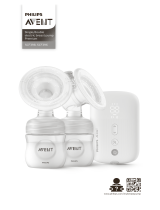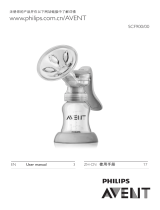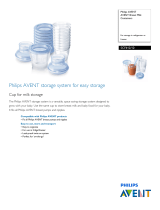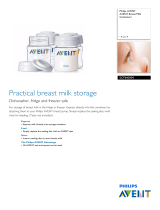
GB
6. (1)–(7)
ÖNEML∞: BEYAZ VALF∞ KAYBETMEY∞N. POMPANIZ BU OLMADAN
VEYA DO≥RU TAKILI OLMA≥INDA ÇALI∑MAYACAKTIR. E≤er
kaybolursa, yedek parçaları Grup LTD.’den temin edebilirsiniz.
Contents
1. Introducing the Manual Breast Pump
2. Detailed parts guide
3. Cleaning and sterilisation
4. Keeping your breast pump sterile for travel
5. Using the Manual Breast Pump with the
AVENT VIA Storage System
6. How to assemble the Manual Breast Pump
7. When to express milk
8. Hints to help you succeed
9. How to use the Manual Breast Pump
10. Storing your breast milk
11. Feeding your baby your expressed breast milk
12. Choosing the right teat for your baby
13. Troubleshooting guide
Please take five minutes to read through the WHOLE
of this leaflet BEFORE you use your Philips AVENT
Manual Breast Pump for the first time.
Should you ever lose these instructions, they are
available on our website: www.philips.com/AVENT
41
13. Sorun çözme rehberi
Çekim yok
Süt sa¤›lm›yor
Sa¤arken gö¤üste
ac› duyuluyor
Silikon Masaj Bafll›¤›na
süt s›z›yor
Pompa parçalar› çatlarsa /
renk de¤ifltirirse
Kay›p veya k›r›lan parçalar
Tüm pompa parçalar›n›n do¤ru olarak tak›ld›¤›n› ve
beyaz y›ld›z contan›n t›rt›kl› k›sm›n›n yukar› dönük
oldu¤unu kontrol edin. Diyafram ile Süt-art›r›c› silikon
masaj bafll›¤›n›n huni k›s›m ve pompa gövdesine arada
hiç boflluk kalmayacak flekilde tak›lm›fl oldu¤undan da
emin olun.
Pompan›n do¤ru olarak tak›ld›¤›ndan ve çekim
sa¤land›¤›ndan emin olun. Rahat olun ve tekrar deneyin,
sa¤›m birkaç denemeden sonra oluflacakt›r. Lütfen
‘Baflar›l› olman›z için yard›mc› ipuçlar›’ bölümüne bak›n›z.
Çok sert pompal›yor olabilirsiniz. Pompan›n meydana
getirece¤i bütün çekim gücünü kullanman›za gerek
yoktur. Pompa kolunu yar›ya kadar bast›rmay› ve 2-3
saniye pompalama ritmini hat›rlay›n. Doktorunuza veya
hemflirenize baflvurun.
Masaj bafll›¤›n› ç›kart›p tekrar tak›n ve huni k›sma iyice
oturdu¤undan emin olun. Öne do¤ru hafifçe e¤ilin.
Çatlama ya da k›r›lmalara neden olaca¤›ndan antibakteriyal
deterjanlar / temizleyicilerle temastan uzak tutun.
Deterjanlar, temizlik ürünleri, sterilizasyon solüsyonlar›,
yumuflat›lm›fl su kombinasyonlar› ve ›s› de¤ifliklikleri, baz›
flartlarda, plasti¤in çatlamas›na neden olabilir. Bu oldu¤unda
pompay› kullanmay›n. Yedek parça temini için Philips
AVENT Türkiye distribütörünü aray›n. Pompan›z› bulafl›k
makinesinde y›kayabilirsiniz ancak yiyeceklerin renkleri
pompa parçalar›n›n renk de¤ifltirmesine neden olabilir.
Ürünü do¤rudan günefl ıflı¤ına maruz bırakmayın aksi
halde renk kaybı olabilir.
Philips AVENT Türkiye Distribütörü GRUP LTD müflteri
hizmetlerine arka kapaktaki iletiflim bilgilerinden ulaflabilirsiniz.
E¤er hala problem yafl›yorsan›z, lütfen Philips AVENT Türkiye Distribütörü
GRUP LTD. müflteri hizmetlerini (iletiflim bilgileri arka kapakta) aray›n.
Alternatif olarak doktorunuza veya hemflirenize dan›flabilirsiniz.
TR
IMPORTANT: DO NOT LOSE THE WHITE VALVE. YOUR PUMP
WILL NOT WORK WITHOUT IT OR IF IT IS FITTED INCORRECTLY.
If lost, spare valves are available direct from Philips AVENT.
ATTENTION : VOTRE TIRE-LAIT NE FONCTIONNERA PAS SANS
CETTE PIÉCE. SI ELLE EST MISE À L’ENVERS OU MAL PLACÉE, IL
N’Y AURA PAS D’ASPIRATION. (Des valves de rechange sont
disponibles.)
















